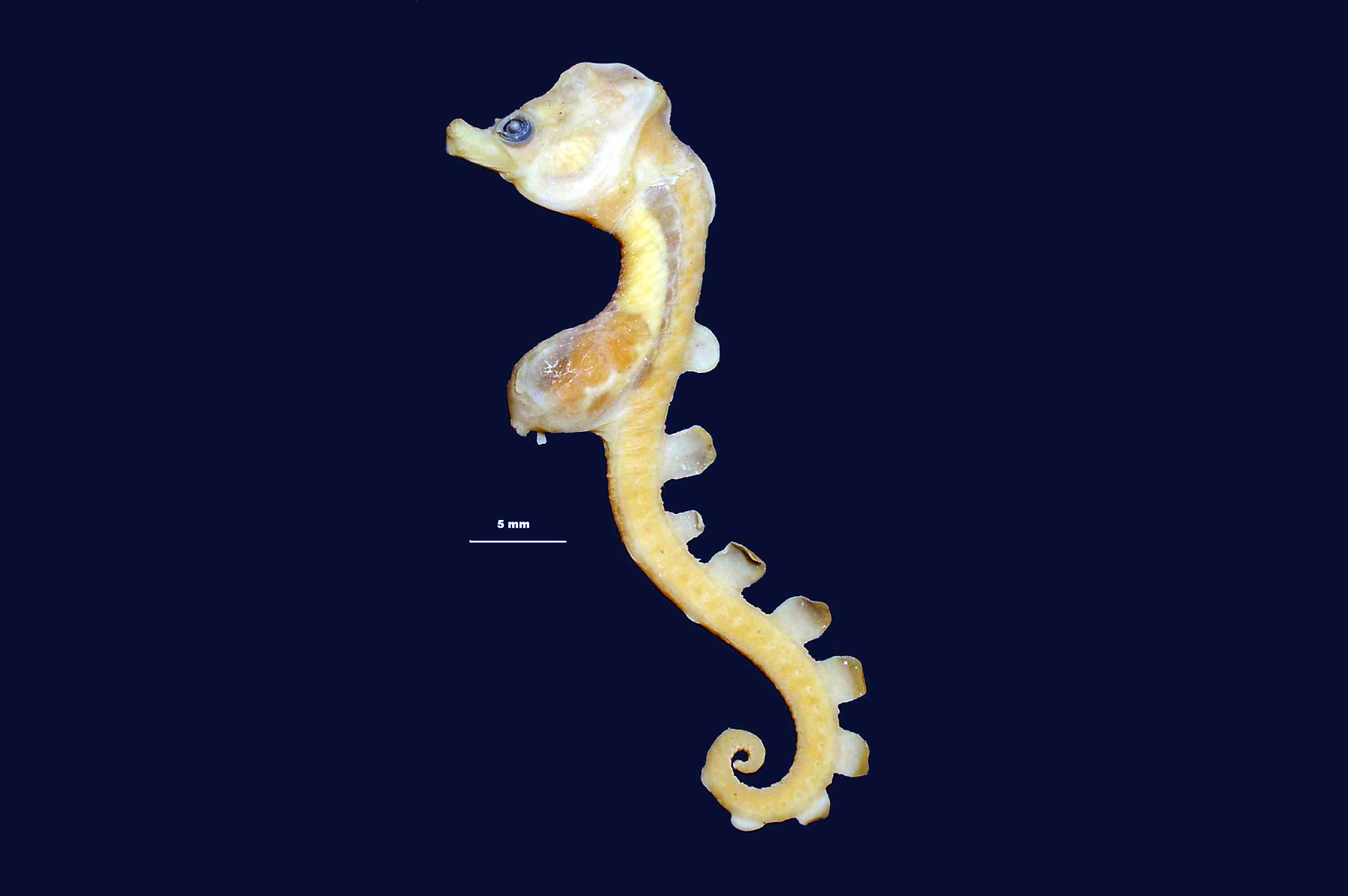Paradoxical Seahorse, Hippocampus paradoxus Foster & Gomon 2010

The Paradoxical Seahorse, Hippocampus paradoxus. Source: Ralph Foster / South Australian Museum. License: All rights reserved
The rare and unusual Paradoxical Seahorse, known from a single female specimen collected of south-western Australia, lacks a dorsal fin and has a series of fleshy, fin-like lobes along the back. The external bony segments are poorly defined because the body is very compressed and fleshy. This species has the lowest number of trunk rings and dorsal-fin rays of any species in the genus Hippocampus.
Paradoxical Seahorse, Hippocampus paradoxus Foster & Gomon 2010
More Info
|
Distribution |
Known only from temperate marine waters southwest of Esperance, Western Australia. The specimen was collected in a benthic sled along with a range of bryozoans and some sponges on a coarse substrate of calcareous sand - depth 102 metres. |
|
Features |
Meristic features: Anal fin 2; Pectoral fin 11; Trunk rings 8: Tail rings 41. A species of Hippocampus with no dorsal fin, a series of fleshy, fin-like lobes along the dorsal midline of the trunk and tail, 8 trunk rings, 11 pectoral-fin rays, an extremely robust cleithrum, and a prominent first nuchal plate. |
|
Size |
64.6 mm |
|
Colour |
In preservative: yellowish-cream peppered with tiny dots; fleshy tubercles on back densely-dotted; a series of faint brown spots, some with pale centres, on dorsal midline between the 3rd and 6th trunk rings. |
|
Feeding |
Presumably carnivorous. |
|
Biology |
The only known specimen of H. paradoxus is a female and has a very large abdomen containing eleven developing eggs, each about 2 mm in diameter. No males are known, however, the pouch is most likely to be in a caudal position, as it is in the closely-related Hippocampus minotaur. Although H. minotaur is technically a tail brooder, the male seems to have an intermediate brooding condition, with the pouch on the tail pushed anteriorly to such extent that it greatly displaces abdominal organs and has the appearance of being abdominal (Gomon 1997). |
|
Fisheries |
Although of no interest to fisheries, the Paradoxical Seahorse may be taken as bycatch in commercial trawls. |
|
Similar Species |
With the crests along its back, and lack of a dorsal fin, the Paradoxical Seahorse cannot be confused with any other species. It is most similar to the closely-related Hippocampus minotaur, being of similar size and body form, and sharing trunk ring, tail ring and pectoral-fin ray counts. Although lacking the obvious dorsal body crests, some specimens of H. minotaur have mid-dorsal tubercular swellings along the back that are very similar in appearance to the distal tubercular swellings on the tail of H. paradoxus. |
|
Etymology |
The species name paradoxus is from Latin meaning 'strange, contrary to all expectation', in reference to the unusual morphology of the Paradoxical Seahorse. |
|
Species Citation |
Hippocampus paradoxus Foster & Gomon 2010, Zootaxa 2613: 62, Figs. 1, 2A, 3. Type locality: Southwest of Esperance, Western Australia, approximately 34°29'S, 121°32'E, depth 102 metres. |
|
Author |
Ralph Foster, Martin F. Gomon & Dianne J. Bray |
Paradoxical Seahorse, Hippocampus paradoxus Foster & Gomon 2010
References
Foster, R. & M.F. Gomon. 2010. A new seahorse (Teleostei: Syngnathidae: Hippocampus) from south-western Australia. Zootaxa 2613: 61-68.


